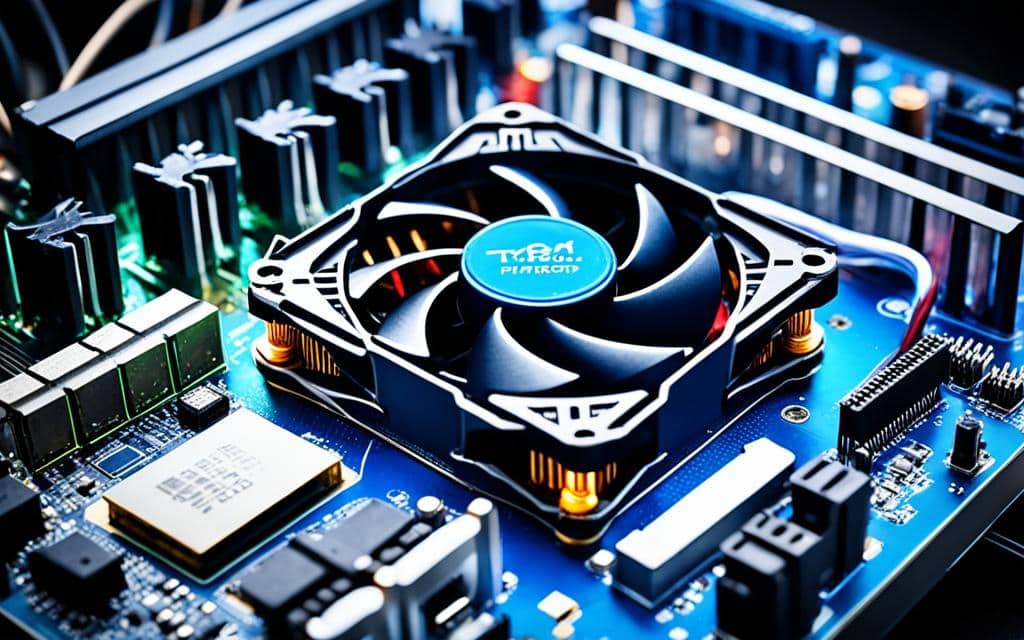When I first saw my CPU fan running at 4000 RPM, I wondered if it was too low. From experience, I know fan speed is important for keeping the CPU cool, especially during tasks like gaming. Let’s explore this together.
Is 4000 RPM Too Low For A CPU Fan? (Short answer)
A CPU fan running at 4000 RPM is generally not too low, especially during heavy tasks like gaming or video editing. Fan speed depends on cooling needs, and 4000 RPM often provides sufficient airflow to maintain safe CPU temperatures.
In this article, we will discuss Is 4000 RPM Too Low For A CPU Fan?
What Is Rpm In A CPU Fan?

RPM in a CPU fan means “Revolutions Per Minute.” It shows how fast the fan is spinning. A higher RPM usually means more airflow to cool the CPU. Fan speed can change based on temperature and the tasks your computer is doing.
Why Does CPU Fan Speed Matter?
CPU fan speed is important for cooling your computer. Faster fans move more air, stopping overheating, which can slow performance or harm parts. Keeping the right speed helps your computer last longer.
Understanding 4000 RPM for a CPU Fan
A CPU fan speed of 4000 RPM is average. It works well for simple tasks like browsing or office work. However, for demanding activities like gaming or video editing, 4000 RPM may not provide enough cooling. You might need a higher RPM for heavier tasks to avoid overheating.
Read Also: Is A CPU Register Falling Edge – A Detailed Overview!
Factors Influencing the Ideal CPU Fan Speed
1. Type of CPU and Usage
Different CPUs need varying cooling levels. High-performance CPUs for gaming or heavy tasks usually need faster fan speeds compared to basic office CPUs. Adjust the fan speed according to your computer’s use to avoid overheating.
2. Ambient Temperature and Airflow
The temperature of the room and airflow impact cooling efficiency. High temperatures or restricted airflow can hinder cooling. Keep your computer in a well-ventilated area and improve airflow to maintain safe CPU temperatures and effective cooling.
3. Size and Design of the CPU Fan
Larger CPU fans can move more air even when spinning slowly, which makes them more efficient. The design of the fan is also important; well-designed fans can cool effectively at lower RPMs. Bigger or better-designed fans help reduce noise while still providing good cooling.
Pros And Cons Of Running A CPU Fan At 4000 RPM

1. Advantages of Lower RPM
- Quieter Operation: Fans running at lower RPMs are quieter, making your computing experience more enjoyable.
- Reduced power consumption: Slower fans consume less energy, improving energy efficiency.
- Less Wear and Tear: Operating at lower speeds puts less strain on the fan, which can help it last longer.
2. Disadvantages and Potential Risks
- Less Effective Cooling: Lower RPM fans may not move enough air, which can lead to higher CPU temperatures.
- Potential Overheating: Inadequate cooling can cause the CPU to overheat, damaging components and harming performance.
- Performance Throttling: To avoid overheating, the CPU might slow down, resulting in reduced system speeds.
How To Check Your CPU Fan Speed?
You can check your CPU fan speed through BIOS settings or software tools. To access the BIOS, restart your computer and press F2 or DEL.
For software options, tools like HWMonitor or SpeedFan can display real-time fan speeds and other system information.
How To Adjust Your CPU Fan Speed?
To change your CPU fan speed, enter the BIOS settings and locate the “Fan Control” section to modify the speed or profile settings.
Alternatively, you can use software tools like MSI Afterburner or Corsair iCUE for more precise control over fan speeds directly from your operating system.
Signs That Your CPU Fan Speed Is Too Low
If your CPU fan speed is too low, you may notice high temperatures, unexpected shutdowns, or that your computer feels hot.
Other signs include system crashes or slower performance. If you encounter these issues, check and adjust your fan speed to avoid overheating.
How To Improve Cooling Without Increasing RPM?

1. Better Thermal Paste Application
To improve heat transfer, apply the thermal paste evenly and sparingly in the center of your CPU. Using a small, uniform amount allows the cooler to make better contact with the CPU, enhancing cooling efficiency and preventing overheating. This practice can extend your CPU’s lifespan and maintain its performance.
2. Upgrading CPU Cooler
Upgrading your CPU cooler can greatly improve cooling performance. A better cooler dissipates heat more effectively, reduces noise, and supports higher workloads.
This enhancement helps keep your CPU cool during demanding tasks, preventing overheating and boosting overall system stability and performance.
3. Enhancing Case Airflow
To enhance case airflow, tidy up cables, install additional fans, and keep vents clear. This promotes efficient heat dissipation, lowers system temperatures, and helps maintain optimal performance and stability for your CPU and other components.
Read Also: Do You Have To Reinstall Windows With A New CPU – Ultimate Guide – 2024
Common Myths About CPU Fan Speed
Many believe that higher RPM always results in better cooling or that a silent fan isn’t effective. However, the efficiency of a fan depends on its design, size, and speed. A well-designed fan can operate quietly while still delivering excellent cooling performance.
Does a high rpm always mean better cooling?
No, higher RPM doesn’t always guarantee better cooling. Although it moves more air, factors like fan design, size, and airflow direction are equally important. A well-designed fan can be more effective at lower speeds than a high-RPM fan.
When Should You Worry About Your CPU Fan Speed?
You should be alarmed if your computer overheats, makes strange noises, or shuts down unexpectedly. These symptoms suggest that the fan isn’t cooling properly. Check the fan speed to ensure it meets your CPU’s needs, preventing potential damage and performance problems.
CPU Fan Keeps Running At 4000+ RPM

If your CPU fan constantly runs over 4000 RPM, it could mean your CPU is heavily taxed or needs better cooling. Inspect for dust buildup and enhance airflow to help regulate fan speed effectively.
CPU Fan Error/Low RPM
A CPU fan error or low RPM usually indicates poor cooling. Check the connections and clean the fan. If issues continue, think about replacing the fan or adjusting the BIOS settings for better performance.
CPU fan speed – what’s normal?
A normal CPU fan speed depends on the workload. For light tasks, speeds between 600 and 1200 RPM are common. For heavy tasks like gaming, it may go up to 2000 RPM or more to keep the CPU cool.
High Rpm CPU Fan
A high-RPM CPU fan cools well but can be noisy. Make sure your system requires this speed for heavy tasks. If not, consider lowering the fan speed for quieter operation.
How To Lower Fans RPM?
To reduce your fan’s RPM, go into the BIOS settings or use software like MSI Afterburner to adjust the speed. Additionally, cleaning the fan and enhancing case airflow can help lower speeds while maintaining effective cooling.
CPU Fan Starting At A Low RPM?
If your CPU fan begins at a low RPM, it might not cool the CPU effectively under heavy use. Check the BIOS or software settings to adjust the speed profile for better cooling when needed.
Low RPM on Processor Fan
Low RPM on a processor fan can lead to inadequate cooling, particularly during heavy use. Check if the fan is working properly, clean any dust, and adjust the speed in BIOS or using software to keep CPU temperatures safe.
Does Having 3800-4000 RPM Could Damage My Fans?

Running a CPU fan at 3800-4000 RPM is usually safe and won’t damage it. However, consistently high speeds can lead to wear over time. Regular maintenance and cleaning help prevent potential problems.
[Troubleshooting] Is 4000 rpm on a CPU normal?
A CPU fan speed of 4000 RPM is normal for many systems, especially during heavy use, as it provides good cooling. If it runs at this speed constantly or during light tasks, check for airflow issues or settings.
Is 2300 rpm normal for CPU fan speed?
A CPU fan speed of 2300 RPM is normal for light to moderate use, offering sufficient cooling for everyday tasks. If temperatures rise, check airflow or adjust fan settings for better cooling.
Read Also: Process Lasso Error Setting Process CPU Affinity – Complete Details in 2024
Is a CPU fan speed of 3590 rpms normal?
A CPU fan speed of 3590 RPM is typical, especially during moderate to heavy use. It shows the fan is actively cooling the CPU. Just make sure it aligns with cooling needs and isn’t too loud.
Crazy CPU Fan Runs At ~5500rpm While Temp Is Ok
If your CPU fan spins at around 5500 RPM while temperatures are normal, it could be a settings issue or a malfunction. Check BIOS or software fan controls and ensure there’s no dust buildup or hardware issues.
Fan Over 4000 RPM On 50% CPU Usage Only

A fan running above 4000 RPM with only 50% CPU usage may signal a problem with fan control settings or cooling efficiency. Check BIOS or software settings to adjust the fan speed appropriately.
Good RPM for CPU Fan
The ideal RPM for a CPU fan varies with usage. Typically, 2000–3000 RPM suffices for everyday tasks, while 3000–4000 RPM is better for gaming or heavy workloads. Adjust based on temperature and noise preferences.
H100i Platinum Fan Only Runs At 4000rpm
If your H100i Platinum fan runs only at 4000 RPM, it may be in a balanced mode. Check the fan curve settings in the control software or BIOS to adjust speeds according to cooling requirements and system load.
Is 4000 RPM Too Low For CPU Fan Gaming?
A CPU fan speed of 4000 RPM may be too low for gaming, especially if your CPU produces significant heat. Consider raising the fan speed or upgrading to a more powerful fan for improved cooling during intense gaming sessions.
CPU Fan: 4000 RPM
A CPU fan running at 4000 RPM is good for moderate tasks. However, it may not cool effectively during heavy use or gaming. Make sure it maintains airflow to keep your CPU safe.
AIO Pump, 4000 RPM
An AIO pump running at 4000 RPM typically provides good cooling for most tasks by circulating coolant effectively. Ensure this speed meets your system’s cooling needs and that the pump is functioning well.
AIO Pump 5000 RPM
An AIO pump running at 5000 RPM enhances cooling performance, particularly during demanding tasks or overclocking. While it improves coolant circulation, it may produce more noise, so balance speed with cooling needs.
Should AIO Pump Run At Full Speed?

The AIO pump doesn’t need to run at full speed all the time. It should adjust according to CPU temperature. Constant full speed can create extra noise and wear, so it’s best to increase speed only when needed for cooling.
CPU Pump Speed Settings
CPU pump speed settings determine how quickly the pump circulates coolant. You can adjust these in the BIOS or software to fit your CPU’s cooling needs. Higher speeds boost cooling but may create more noise, so find a balance between performance and noise levels.
My CPU fan is running very High Speed Even With Less CPU Usage
If your CPU fan runs at high speeds despite low usage, it could be a settings problem or faulty temperature sensors. Review the BIOS or fan control software to adjust the settings for better cooling efficiency.
Does the RPM of Case Fans Make A Big Cooling Difference?
Yes, case fan RPM significantly impacts cooling. Higher RPM fans move more air, enhancing overall system cooling. However, it’s essential to balance airflow and noise for the best performance and comfort.
FAQ,s
1. Is 5000 RPM fan speed bad?
No, 5000 RPM fan speed isn’t bad, but it can indicate your system is working hard to cool down. If it’s consistently high, check for dust buildup or overheating issues.
2. Is 3000 rpm good for CPU fan?
Yes, 3000 RPM is generally good for a CPU fan, especially under heavy load. It means the fan is cooling the CPU efficiently. Lower RPMs are fine for lighter tasks.
3. What RPM Should My CPU Be At?
CPU fan RPM depends on workload and cooling needs. For idle or light tasks, 600–1200 RPM is common. Under heavy load, it can range from 2000–3000 RPM or higher for better cooling.
4. What Is A Good RPM for A Fan?
A good RPM for a fan depends on its size and purpose. Case fans typically run between 1000 and 1500 RPM, while CPU fans may go from 1500 to 3000 RPM, depending on cooling needs.
5. Is a 6000 RPM fan good?
A 6000 RPM fan is quite fast and can provide excellent cooling. However, it may be noisy and is usually needed only for high-performance systems or extreme cooling situations.
6. Is 2000 RPM PC Fan Good?
Yes, a 2000 RPM PC fan is good, especially for CPU or high-performance case cooling. It offers a balance between airflow and noise, providing decent cooling for most setups.
7. Is 1000 rpm good for Fan?
Yes, 1000 RPM is good for case fans under light to moderate tasks. It provides quiet operation while offering adequate cooling. For heavy tasks, higher RPMs may be needed.
8. CPU Fan Over 4000 RPM When Simply Browsing A Website, And Much More When Gaming
If your CPU fan runs over 4000 RPM while just browsing, it might indicate overheating or dust buildup. Check for proper ventilation, clean the fans, or adjust the fan curve in BIOS settings.
9. Why Do My Fans Ramp Up Over 4000 RPM, When The Fan Curve Only Shows 2960 Rpm Max In Gcc?
Your fans may ramp up over 4000 RPM if there’s a sensor issue, BIOS override, or incorrect settings in GCC. Try updating the software, checking your BIOS, or recalibrating the fan curves.
10. CPU Is Hot, And CPU Fan Making Very Many RPms and Much Noise (CPU Fan Not Listed In Speedfan)
If your CPU is hot and the fan is noisy but not listed in SpeedFan, it could mean SpeedFan doesn’t support your fan or sensor. Check your BIOS for fan control options, clean the fan, or consider a better thermal paste for cooling.
Conclusion
4000 RPM for a CPU fan is generally sufficient for light to moderate use, such as web browsing or office work. However, for high-performance tasks, gaming, or overclocking, you may need to increase your fan speed or upgrade your cooling solution to prevent overheating. Regular maintenance and monitoring are crucial to ensure your fan is running at optimal speed, protecting your CPU from thermal issues.
Also Read
- Process Lasso Error Setting Process CPU Affinity – Complete Details in 2024
- Do You Have To Reinstall Windows With A New CPU – Ultimate Guide – 2024
- Is A CPU Register Falling Edge – A Detailed Overview!



